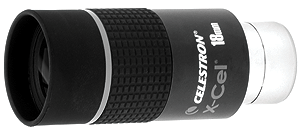Celestron X-Cel Series Eyepieces By the Astronomy and Photography Online Staff  For many years Celestron's bread and butter eyepieces have been Plossls. The Omni line is their current Plossl offering and good oculars they are. (They are covered in an article you can find on the Astronomy and Photography index page.) The Plossl design uses four lens elements in two symmetrical groups. This apochromatic design provides a flat field, excellent sharpness, good contrast from center to edge, a reasonable apparent field of view (AFOV) of around 50 degrees and decent eye relief in medium and long focal lengths (from about 15mm and longer). The eye relief becomes limited, as does the exit pupil, in short focal length Plossls. Because Plossl's tend to have rather small exit pupils in high magnification oculars and a short eye relief, viewing is difficult for most observers and practically impossible for eyeglass wearers. Ditto for orthoscopic oculars, another classic four-element design found in short focal length oculars. Advances in optical design and manufacturing technology made it possible to manufacture short focal length oculars with a generous apparent field of view, extended eye relief, flat field, excellent sharpness from center to edge and an adequate exit pupil. Burgess/TMB Planetary and Tele Vue Radian eyepieces are two examples of such eyepieces recently reviewed on the Astronomy and Photography Information Guide. The X-Cel line, now the "enhanced" X-Cel LX line, is Celestron's entry in this upscale ocular arena. The recently discontinued X-Cel design formula used six elements, including two elements of extra low dispersion (ED) glass for the most curved elements to minimize lateral color error (color fringing). All lens elements were fully multi-coated, edge-blackened and the eyepieces' internal barrel surfaces were flat black to help reduce internal reflections. The angular field of view of all X-Cel eyepieces was 55-degrees and the eye relief was 20mm, regardless of focal length. This put them in the ballpark with the aforementioned Burgess/TMB and Tele Vue oculars. Celestron X-Cel eyepieces came with 1.25" mounting barrels in the following focal lengths: 2.3mm, 5mm, 8mm, 10mm, 12.5mm, 18mm and 25mm. In September of 2010, Celestron introduced a new X-Cel LX ocular line. These differ from the original X-Cel oculars by incorporating a twist up eyeguard and a wider 60-degree AFOV. The new focal lengths are 2.3mm, 5mm, 7mm, 9mm, 12mm, 18mm and 25mm. A six element optical design has been retained, but without the use of ED glass elements. X-Cel LX oculars are parfocal, meaning that little or no refocusing is necessary when changing oculars. Externally, they have black barrels with orange graphics. 2010 MSRP is $74.95 for all focal lengths. As we write these words, the last of the old X-Cel oculars are being closed out by dealers. Henceforth, only X-Cel LX oculars will available. The original X-Cel eyepieces that are the main subect of this review were manufactured by Celestron's partner and owner, Synta, in Red China. They came with hard chrome plated mounting barrels that included a wide safety notch to reduce the chance of loss if a star diagonal retaining screw should accidentally loosen. The mounting barrels were threaded to accept standard 1.25" filters. Their aluminum upper barrels were finished in an attractive matte black with a Celestron orange accent stripe and featured a wide, checkered, black rubber grip band. There was a rubber eye guard on the top of the ocular. Top and bottom caps and a protective plastic case were provided with every X-Cel eyepiece. Here are some basic specifications for the X-Cel Series eyepieces:  Photo courtesy of Celestron International.
Celestron's 2009 MSRP for X-Cel oculars was $86.99 and online discount prices were considerably lower. Optics Planet (www.opticsplanet.com), for example, sold X-Cel's for only $56.45 each. That is a little over half the price of a Burgess/TMB Planetary and about � of the price of a Radian. This was made possible by Synta/Celestron's manufacturing and marketing power. The image through a Celestron X-Cel ocular is sharp and contrasty with little light scatter. The AFOV is sharp from center to edge and it is comfortably wide, without being so wide that you have to move your head around to see the entire field of view. (We prefer apparent AFOV's in the 55-70 degree range.) The rubber eye guard helps to exclude ambient light as well as protect the eye. Eyeglass wearers can fold back the eye guard. We like wide field, long eye relief oculars in the short and medium focal lengths. We own and use Burgess/TMB Planetary, Tele Vue Radian and Celestron X-Cel oculars in focal lengths from 25mm down to 4mm. All three brands perform in an exemplary fashion. Frankly, using our Mark I eyeballs, we cannot see much difference in the visual performance of the three brands, or between the old and new X-Cel lines. They are all easy to view through and they all work great in our various telescopes. The Celestron and Tele Vue lines have slightly greater eye relief than the Burgess/TMB (20mm Vs. 16mm). The Planetary and Radian oculars have deluxe pull-up or twist-up eye cups that the original X-Cels lacked, but the new X-Cel LX line has corrected that deficiency. We think that Celestron X-Cel and X-Cel LX eyepieces are very good and we highly recommend them. |